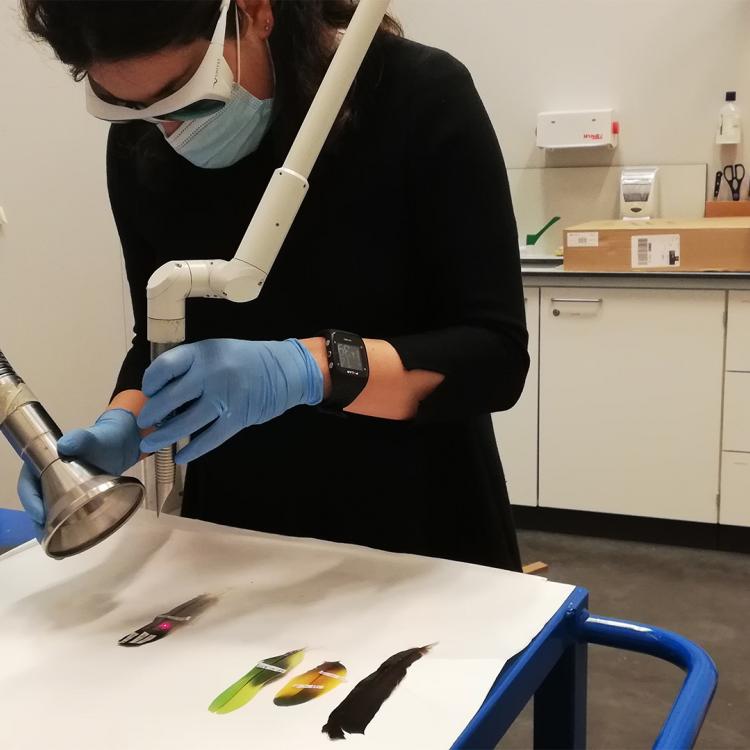Key project information
Duration
April 2016 – September 2021
Contact details
Email: science@britishmuseum.org
Supported by
Ed and Anne Teppo
Mellon Foundation
American Friends of the British Museum
Can lasers help conservators deal with museum objects that can be difficult to clean using conventional techniques?
The British Museum has been researching the use of laser technology as part of its artefact cleaning and conservation activity since 2005. Lasers are non-contact and very accurate, which is extremely useful for conservators when preserving and caring for important historical objects.
Conservators routinely use lasers to remove pollution soiling from stone artefacts. Yet there’s been little research into their use on other materials such as feathers or archaeological metals, despite their great potential for supporting complex conservation projects.
This project has brought together a team of scientists and conservators at the British Museum to investigate whether laser cleaning can be used for materials other than stone.
Find out about the latest project news.
About the project
Laser cleaning is a non-contact technique and, as such, it has great potential for conservators faced with challenging situations. For example, some objects are too fragile to be handled or their surfaces are so delicate that they would be damaged even by gentle brushing.
Using lasers for conservation projects comes with its own risks as they could cause burning or discolouration if their parameters are not finely tuned. They can also trigger physical and chemical changes to an object that are invisible to the naked eye. Lasers are routinely used on marble, sandstone and limestone objects to remove black pollution layers. However, little is known about the risks and benefits of using lasers to clean other materials or their effectiveness at removing other types of contaminants.
In this project, a team of scientists and conservators investigated the use of the Museum’s Nd:YAG and Er:YAG lasers on a wide selection of artefacts. They began by testing mocked-up samples made from a range of materials so that adjustments could be made to the laser parameters. Then, scientists employed a full range of analytical techniques to determine whether lasers were appropriate for cleaning each of these materials. Finally, using these results, conservators safely ran tests on Museum objects.
Aims
This project has explored the use of laser cleaning in conservation to address the following challenges:
- Cleaning fragile and delicate objects, which could be damaged by gentle brushing.
- Removing old adhesives in conservation treatments that tended to yellow with time and become disfiguring. These need to be removed and replaced with more appropriate adhesives. However, unlike freshly applied adhesives, old adhesives are very difficult to remove using solvents.
- Removing so-called ‘cemented dust’. If not regularly removed, dust can accumulate and lead to the formation of a ‘sticky’ layer, which cannot be removed using gentle vacuum-cleaning and dusting and requires the use of solvents.
- Removing corrosion from gilded metal surfaces, which are easily damaged using conventional methods.
The results of this project have been made available to heritage scientists and conservators to raise awareness of the potential of laser cleaning. This research has also been shared in journal articles and presentations at international conferences and a symposium at the British Museum.
Conclusion
The Er:YAG laser was found to be very effective for the removal of old adhesives from a wide range of materials (shell, ceramics and a late antique wall-painting). It was also successful at removing cemented dust from limestone and painted plaster, as well as old mould from Cypriot polychrome archaeological terracotta and limestone. Conservators managed to remove thick corrosion from a gilded archaeological silver object.
Tests on feathers showed that white feathers could be laser cleaned effectively with the Nd:YAG laser but extensive damage was observed on dark feathers. The Er:YAG caused burning on all types of feathers.
The project has shared research outcomes in several blogs and a YouTube video on the British Museum’s channel. Laser cleaning has also been the focus of a showcase event in the Members' Room at the British Museum.
The team working on the removal of mould from Cypriot archaeological terracotta received the Nigel Williams Prize for an outstanding conservation project in 2019.
Thanks to this research, laser cleaning is now used by British Museum conservators on a wide range of materials.
Meet the team

Capucine Korenberg
Principal Investigator
Department of Scientific Research
British Museum

Duygu Camurcuoglu
Conservation Lead
Department of Collection Care
British Museum

Lucía Pereira-Pardo
Research Assistant
Department of Scientific Research
British Museum

Lucia Melita
Research Assistant
Department of Scientific Research
British Museum

Moira Bertasa
Research Assistant
Department of Scientific Research
British Museum
Meet the team continued
Outputs
Investigating the potential of the Nd:YAG and Er:YAG lasers for the cleaning of feathers: a pilot study
JOURNAL ARTICLE
Moira Bertasa; Capucine Korenberg
Heritage Science 10, 153
Published in 2022
Successes and challenges in laser cleaning metal artefacts: A review
JOURNAL ARTICLE
Moira Bertasa; Capucine Korenberg
Journal of Cultural Heritage 53: pages 100–117
Published in 2022
Laser cleaning Cypriot terracotta and limestone figurines
VIDEO
Duygu Camurcuoglu talks about a current Members Room display that opened in May 2021.
Published in 2021
Investigating the potential of the Er:YAG laser for the removal of cemented dust from limestone and painted plaster
JOURNAL ARTICLE
Lucia Melita; Katarzyna Węgłowska; Diego Tamburini; Capucine Korenberg
Coatings 10(11), 1099
Published in 2020
Tackling conservation challenges using erbium lasers: case studies at the British Museum
JOURNAL ARTICLE
Lucía Pereira-Pardo; Lucia Melita; Capucine Korenberg
Journal of the Institute of Conservation 43(1): pages 25−43
Published in 2020
A Symposium in Conservation Science held at The British Museum, organised by Mellon fellows: Lucia Melita and Lucia Pereira Pardo
Held in 2019
The use of an Er:YAG laser in the removal of biological growth from polychrome archaeological terracotta figurines from Cyprus
BOOK CHAPTER
Lucía Pereira-Pardo; Duygu Camurcuoglu; Miriam Orsini; Katarzyna Węgłowska; Thomas Kiely
Recent Advances in Glass and Ceramics Conservation. Proceedings of the ICOM-CC/ICON UK Ceramics and Glass Working Group Interim Meeting 5–8 September 2019.
Published in 2019
The use of erbium lasers for the conservation of cultural heritage. A review
JOURNAL ARTICLE
Lucía Pereira-Pardo; Capucine Korenberg
Journal of Cultural Heritage 31: pages 236–247
Published in 2018
Laser cleaning of a wall painting from Byzantine Egypt
VIDEO
Lucía Pereíra-Pardo explains how the Museum employs the latest laser technology to conserve heritage objects.
Published in 2018






